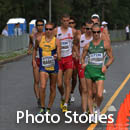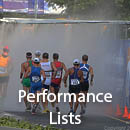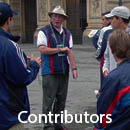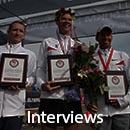CURT CLAUSEN


Birthday: October 9, 1967
Current Residence :
Hometown: Trenton, NJ
College: Duke University (1990)
PRS
Outdoors
20 km - 1:23:34
Indoors
5 km - 19:43
Curt Clausen has been race walking since he was 12 years old. Participating in the Stevens Point, WI, summer track and field program, Clausen was first introduced to the race walk in the summer of 1980.
Growing up, Clausen found the proximity of the University of Wisconsin at Stevens Point provided many fine race walking role models. He originally competed in distance running, but a demonstration by NAIA Nationals champ Jeff Ellis of Steven Point sparked his interest in walking. The following summer session, Clausen began race walk training with Coach Dave Bachman. Balancing running and race walking each summer, he experienced little success.
his pattern continued until Clausen, 17, headed for the 1985 Junior Nationals. His race plan was to stick with Tony Englehart, the 1984 champ. Unfortunately, Englehart wasn’t ready to duplicate his previous feat and Clausen found himself too far behind to challenge for the lead.
A few months later, Clausen put it all together. Instead of running cross-country and track as he had in previous years, he decided to concentrate solely on race walking for his senior year. His focus paid off as he led the Junior squad at the North America’s Cup to an overall U.S. Team Championship.
His goal was to win the Junior Nationals and qualify for the World Junior Championships in Greece, which is exactly what he did! After high school, he enrolled at Duke University, where he continued walking, training hard only three to four months a year. Although few people remember it, Clausen won the Intermediate Age Group Championships as a freshman. The ill-fated race was sparsely attended. I should know, I was the only other race walker.
In 1988 Clausen entered his first Olympic Trials and finished the 50K in 15th place. Shortly afterwards he won his first National title at the 40K National Championships. But this successful experience was not enough to motivate Clausen to stop dabbling and focus on race walking. For the next few years he raced the indoor circuit, became fit by June, raced at Nationals and participated in the U.S. Olympic Festival.
Unlike many New Year’s resolutions that go by the wayside, Clausen’s 1995 commitment to dedicate himself to race walking proved true. At first he found it tough, but by June he finished 5th at Nationals. For more than a year preceding the 1996 Olympic Trials, Clausen trained continuously for the first time in his life, replacing running workouts with a lot more race walking.
By March 1996, Clausen had attained the initial step—on his first attempt—by meeting the time standard required to participate in the Olympic Games at the National Invitational in Washington, D.C. With the standard out of the way, all he needed to do was win the Olympic Trials. He remained in North Carolina to acclimate to the heat and practiced on the Atlanta racecourse where the Trials would be held. He developed his race plan and a related mental image. Realizing that at one time or another he had beaten all top U.S. race walkers, including the #1 ranked Allen James, Clausen set his sights on training harder to achieve this goal. And beat James he did, winning the 1996 20K Olympic Trials and making the Olympic team.
Clausen’s first Olympic experience was disappointing. Frankly, he got his ass kicked. The reason? While Clausen trained for the Olympic Games, he worked 40 to 60 hours weekly and coached himself. Meanwhile, other Olympic athletes trained full time with the guidance of a coach.
Clausen wanted to return to the Olympics, and not as an also walked. He wanted to know that he had tried everything he could to achieve all he could, so he packed up and moved to Chula Vista, California, home of a new Olympic Training Center. In 1999, Clausen had three quality breakthroughs. Under Coach Bhodan Bulakowski, he developed a strong base. Coach Enrique Pena tweaked it to perfection. At the 35K mark of the 50K Nationals, he was on pace to walk 4:00. In the final 15K, he made up six minutes to finish in 3:54.
Brimming with confidence, Clausen excelled. Walking a 19-and change 5K the day before a 2:14 30K workout, Clausen felt he was ready for the World Cup, but then the ceiling caved in. Clausen felt his entire body was broken down. With only two weeks to the World Cup, he decided to take five days off to recover. With low expectations, Clausen started the race with the second pack, walking a surprising time of 3:48 and finishing 11th.
Next Clausen set his sites for the World Championships. His plan from the start was to beat Robert Korzeniowski, who apparently had made a derogatory comment to Clausen’s coach Bulakowski at a previous race. Clausen matched Korzeniowski stride for stride until the unexpected happened: Korzeniowski DQ’d at 37.5K. Without a game plan, Clausen ground it down, making sure no one caught him. Walking a 3:50:50 in 106-degree heat, Clausen crossed the line fourth, feeling “the most dead” he had ever been. Justly, he was eventually awarded the bronze medal when another top finisher failed a drug test.
Clausen also qualified for the 2000 Olympics. Unfortunately, after mid-July knee surgery, he couldn’t walk a step until eight weeks before his race. Needless to say, he was not happy with his results. He finished 22 nd: an improvement over 1996, but not where he wanted to be.
In 2001 Clausen returned to the World Championships, finishing 7th. After his return to top-ten status internationally, his next two years proved disappointing, with a series of setbacks hampering his progress. Bronchitis just before the World Cup, a disqualification at the World Championships, and a controversial disqualification 48K into the Pan Am Cup have kept Clausen hungry.
In 2004, Clausen had his sight set on one last attempt at an Olympic medal. The Olympics were back in Greece, where he had competed more than once. He looked to the heat and a tough course as an advantage: the equalizer, as he put it.
Clausen hit the first milestone on his 2004 quest for Olympic glory. In the 50K Trials race, he battled early stomach problems and stiff competition. The elder statesman of our sport overcame it all, walked negative splits, and qualified for the Olympic Games with a time of 3:58:24. He would go on to finish his 3rd Olympics in 4:11:31.
2003
4th - 1:25:15.9
2002
5th - 1:29:33
2001
1st - 1:24:50
2000
2nd - 1:23:56
1999
1st - 1:23:34
1998
1st - 1:23:58
1997
1st - 1:24:41
1996
1st - 1:25:41
1995
5th - 1:29:21
1993
7th - 1:32:36
1991
8th - 1:31:09
2003
1st - 4:08:36
2002
2nd - 3:58:13
2001
1st - 3:50:46
2000
4th - 3:56:16
1999
1st - 3:48:04
1998
1st - 3:57:24
1990
9th - 4:28:27
None
2004
15K - 1:04:40
2003
30K - 2:15:56
40K - 3:25:28
50K - 4:39:32
2002
50K - 3:58:55
10K - 42:20
2001
5K - 20:44
20K - 1:24:40.36
30K - 2:19:32
2000
50K - 3:56:16
50K Olympic Trials - 3:56:16
1999
10K - 43:08.2
20K - 1:23:34
50K - 3:54:38
1998
5K - 21:04
50K - 3:57:24
1997
5K - 20:33
10K - 42:04
20K - 1:27:12
40K - 3:16:42
1996
10K - 43:22
20K - 1:29:50
20K Olympic Trials- 1:29:50
1988
40K - 3:25:51
20K Olympic Games
1996 – 50 th - 1:31:38 – Atlanta, USA
50K Olympic Games
2004 – TBD – Athens, Greece
2000 – 22 nd - 3:58:39 – Sydney, Australia
50K World Championships
2003 – DQ – Paris, France
2001 – 7 th - 3:50:46 – Edmonton, Canada
1999 – 3 rd - 3:50:55 – Seville, Spain
20K World Championships
1997 – 34 th - 1:32:05 – Athens, Greece
50K World Cup
2002 – DQ - Torino, Italy
1999 – 11 th – 3:48:04 – Mezidon, France
20K World Cup
1997 – 60 th – 1:24:41 - Podebrady, Czechoslovakia
20K Pan Am Games
1999 – 6th – 1:23:39 - Winnipeg, Canada
20K Pan Am Cup
2003 – 15 th - 1:30:45 - Chula Vista, USA
2000 – 12 th – 1:29:59 – Poza Rica, Mexico
1998 – 10 th - 1:37:11 - Miami, USA
1996 – DQ – Manaus, Brazil
50K Pan Am Cup
2003 – DNF – Tijuana, Mexico
2001 – DQ - Cuenca, Ecuador - (while leading the race @ 47 km)





